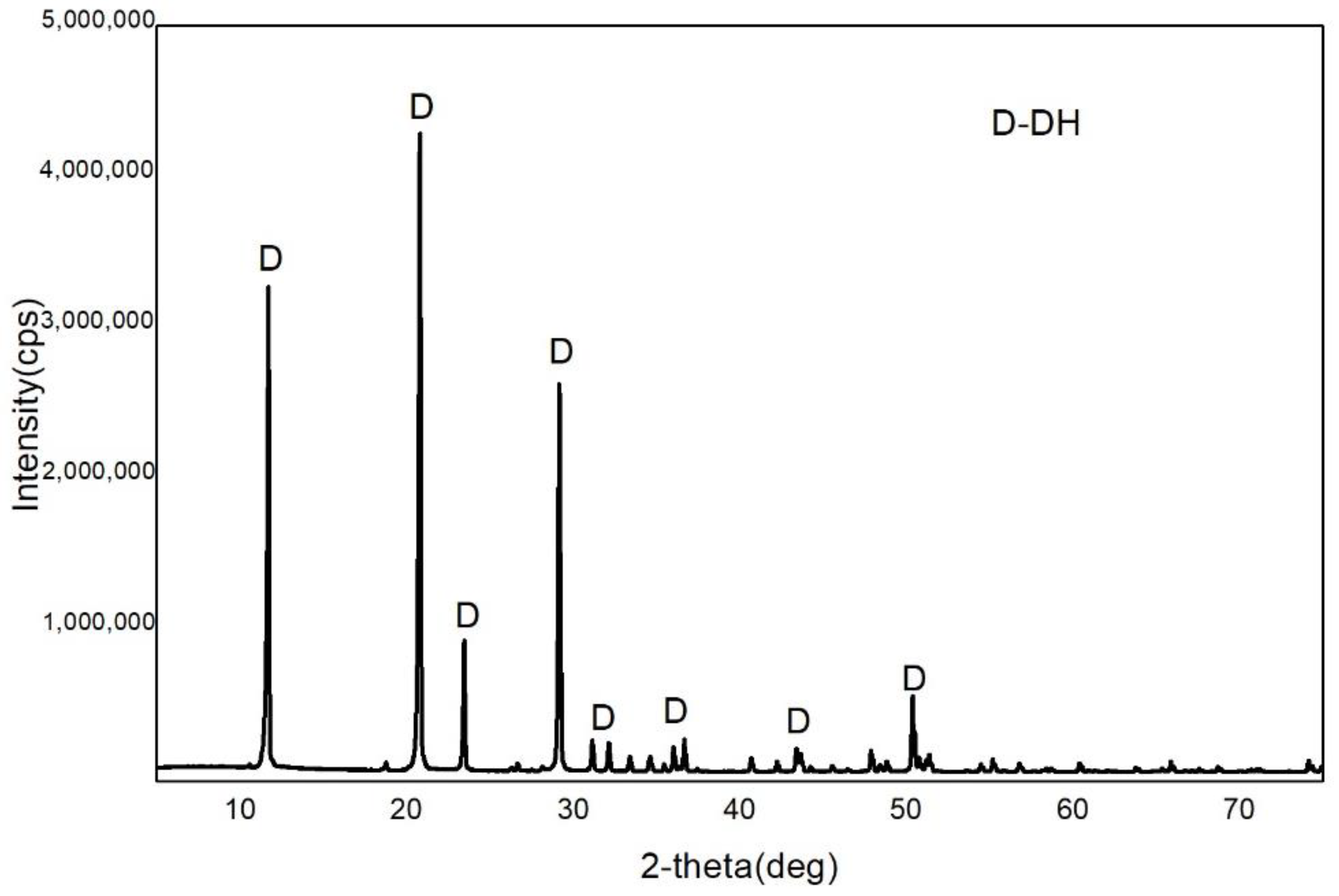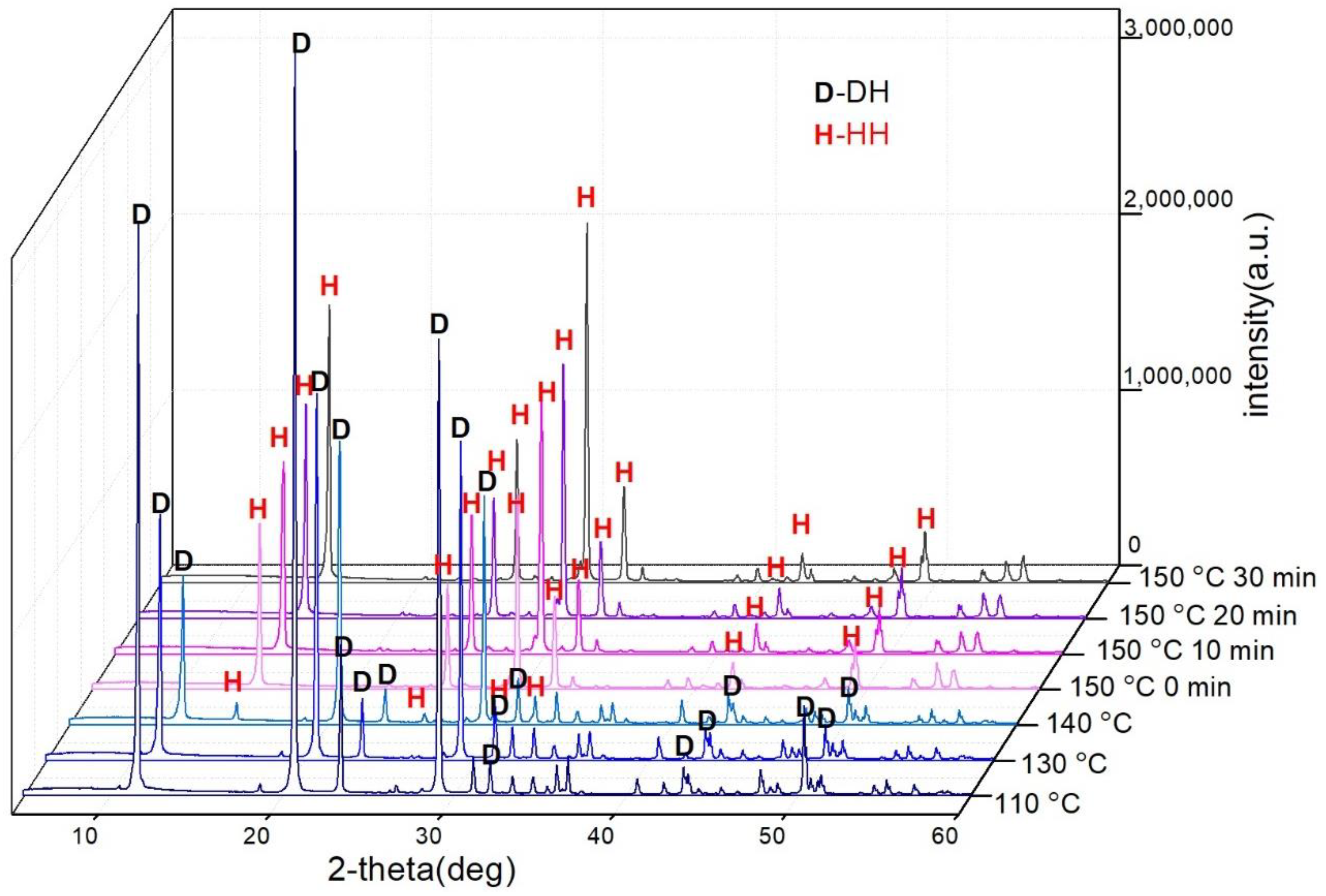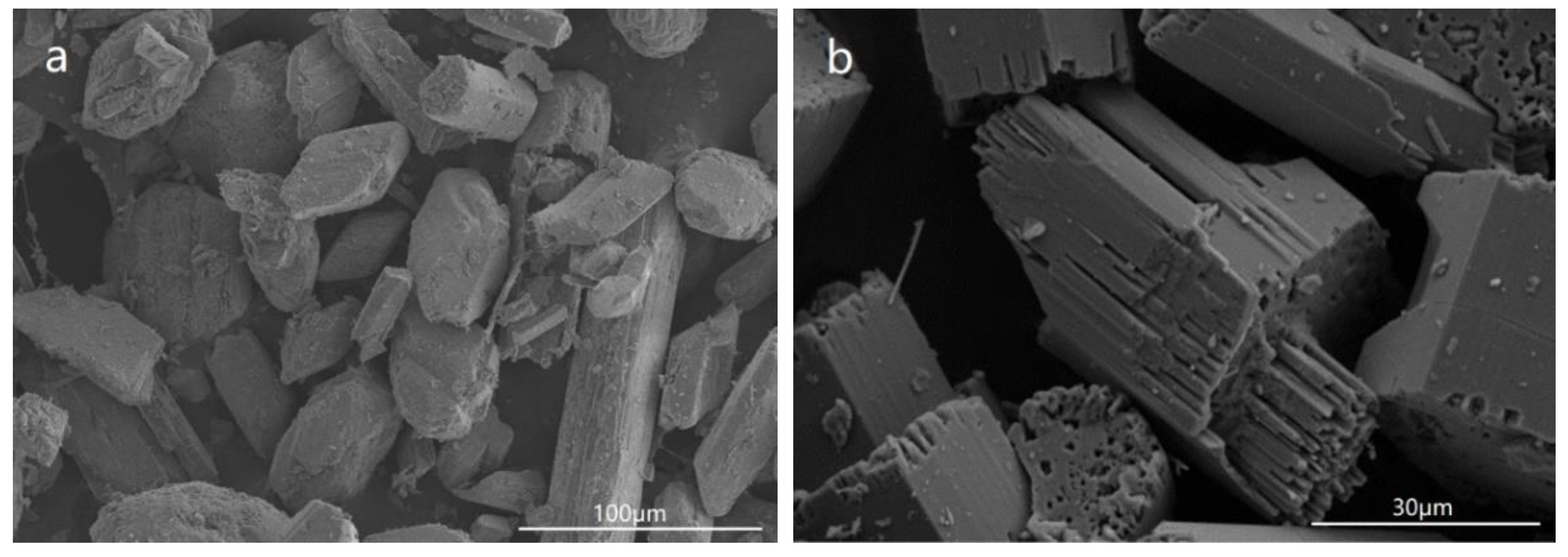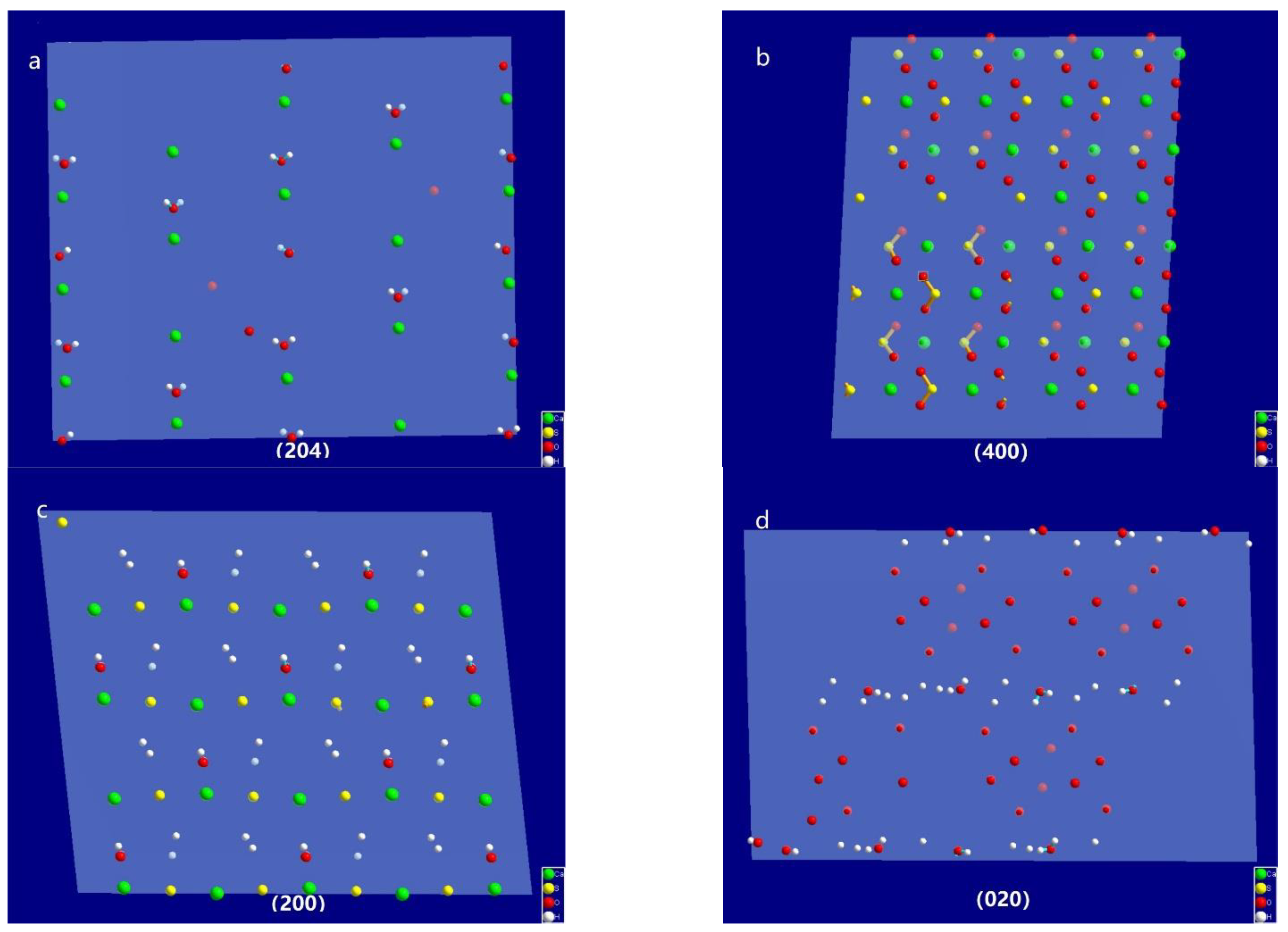Experimental Study and Mechanism Analysis of Preparation of α-Calcium Sulfate Hemihydrate from FGD Gypsum with Dynamic Method
Abstract
:1. Introduction
2. Materials and Methods
2.1. Materials
2.2. Experimental Procedures
2.3. Characterization
2.4. Single-Crystal Diffraction Experiment for the Crystal Structure
3. Results
3.1. The Physical Performances
3.2. Components and Morphology of the Samples at Different Reaction Stages
3.3. Dehydration of FGD Gypsum with Different Contents of Attachment Water
3.4. FTIR Results of α-HH with Different Modifier Dosages
3.5. Results of the Single-Crystal Diffraction
3.6. Analysis of the α-HH Crystal Structure
4. Discussion
5. Conclusions
Author Contributions
Funding
Institutional Review Board Statement
Informed Consent Statement
Data Availability Statement
Acknowledgments
Conflicts of Interest
References
- Tesárek, P.; Drchalová, J.; Kolísko, J.; Rovnaníková, P.; Černý, R. Flue gas desulfurization gypsum: Study of basic mechanical, hydric and thermal properties. Constr. Build. Mater. 2007, 21, 1500–1509. [Google Scholar] [CrossRef]
- Ozkul, M.H. Utilization of citro- and desulphogypsum as set retarders in Portland cement. Cem. Concr. Res. 2000, 30, 1755–1758. [Google Scholar] [CrossRef]
- Guan, B.; Yang, L.; Fu, H.; Kong, B.; Li, T.; Yang, L. α-calcium sulfate hemihydrate preparation from FGD gypsum in recycling mixed salt solutions. Chem. Eng. J. 2011, 174, 296–303. [Google Scholar] [CrossRef]
- Potgieter, J.H.; Potgieter, S.S.; Mccrindle, R.I.; Strydom, C. An investigation into the effect of various chemical and physical treatments of a South African phosphogypsum to render it suitable as a set retarder for cement. Cem. Concr. Res. 2003, 33, 1223–1227. [Google Scholar] [CrossRef]
- Geraldo, R.H.; Costa, A.R.D.; Kanai, J.; da Silva, J.; Souza, J.D.; Andrade, H.M.; Gonçalves, J.P.; Fontanini, P.; Camarini, G. Calcination parameters on phosphogypsum waste recycling. Constr. Build. Mater. 2020, 256, 119406. [Google Scholar] [CrossRef]
- Lewry, A.J.; Williamson, J. The setting of gypsum plaster. J. Mater. Sci. 1994, 29, 5279–5284. [Google Scholar] [CrossRef]
- Shen, Z.; Guan, B.; Fu, H.; Yang, L. Effect of potassium sodium tartrate and sodium citrate on the preparation of α-calcium sulfate hemihydrate from flue gas desulfurization gypsum in a concentrated electrolyte solution. J. Am. Ceram. Soc. 2009, 92, 2894–2899. [Google Scholar] [CrossRef]
- Schmidt, H.; Paschke, I.; Freyer, D.; Voigt, W. Water channel structure of bassanite at high air humidity: Crystal structure of CaSO4·0.625H2O. Acta Cryst. 2011, B67, 467–475. [Google Scholar] [CrossRef]
- Follner, S.; Wolter, A.; Preusser, A.; Indris, S.; Silber, C.; Follner, H. The setting behavior of α- and β- CaSO4·0.5H2O as a function of crystal structure and morphology. Cryst. Res. Technol. 2002, 37, 1075–1087. [Google Scholar] [CrossRef]
- Chen, Y.; Yue, W.; Dong, R. Gypsum Building Material; China Architecture & Building Press: Beijing, China, 2003. [Google Scholar]
- Jiang, G.M.; Wang, H.; Chen, Q.S.; Zhang, X.; Wu, Z.; Guan, B. Preparation of alpha-calcium sulfate hemihydrate from FGD gypsum in chloride-free Ca(NO3)2 solution under mild conditions. Fuel 2016, 174, 235–241. [Google Scholar] [CrossRef]
- Kudo, Y. Process for Production α-Form Gypsum Hemihydrate. U.S. Patent 4842842, 15 June 1989. [Google Scholar]
- Duan, Z.; Qin, H.; Li, G.; Tang, X.; Wen, Z. Research on crystal form modifying agent and technological parameters of high strength α-hemi-hydrated gypsum made with desulfogypsum. New Build. Mater. 2008, 8, 1–4. [Google Scholar]
- Combe, E.C.; Smith, D.C. Studies on the preparation of calcium sulphate hemihydrate by an autoclave process. J. Appl. Chem. 2007, 18, 307–312. [Google Scholar] [CrossRef]
- Ling, Y. Direct Preparation of Alpha-Calcium Sulfate Hemihydrate from Sulfuric Acid. Ph.D. Thesis, McGill University, Montreal, QC, Canada, 2003. [Google Scholar]
- Rüter, H.; Cherdron, E.; Fritz, F. Process for Preparing Alpha Calcium Sulfate Semi-Hydrate from Synthetic Gypsum. U.S. Patent 3337298, 21 May 1967. [Google Scholar]
- Kosugi, J.; Kudo, Y.; Tagaya, K. Method for Production of Alpha Type Calcium Sulfate Hemihydrate. U.S. Patent 4091080, 14 October 1976. [Google Scholar]
- Guan, Q.; Hu, Y.; Tang, H.; Sun, W.; Gao, Z. Preparation of α-CaSO4·1/2H2O with tunable morphology from flue gas desulphurization gypsum using malic acid as modifier: A theoretical and experimental study. J. Colloid Interface Sci. 2018, 530, 292–301. [Google Scholar] [CrossRef] [PubMed]
- Jia, C.; Chen, Q.; Zhou, X.; Wang, H.; Jiang, G.; Guan, B. Trace NaCl and Na2EDTA mediated synthesis of α-calcium sulfate hemihydrate in glycerol-water solution. Ind. Eng. Chem. Res. 2016, 55, 9189–9194. [Google Scholar] [CrossRef]
- Kong, B.; Guan, B.; Yates, M.Z.; Wu, Z. Control of α-calcium sulfate hemihydrate morphology using reverse microemulsions. Langmuir 2012, 28, 14137–14142. [Google Scholar] [CrossRef]
- Chen, C.R.; Qin, S.Y.; Li, S.X.; Wen, J.L. Finite element analysis about effects of particle morphology on mechanical response of composites. Mater. Sci. Eng. A—Struct. 2000, 278, 96–105. [Google Scholar] [CrossRef]
- Sonnier, R.; Leroy, E.; Clerc, L.; Bergeret, A.; Lopez-Cuesta, J.M. Polyethylene/ground tyre rubber blends: Influence of particle morphology and oxidation on mechanical properties. Polym. Test. 2007, 26, 274–281. [Google Scholar] [CrossRef]
- Alfred, Z.; Ivan, O.; Felicia, T.; Katarina, B. Autoclave-free formation of α-hemihydrate gypsum. J. Am. Ceram. Soc. 1991, 74, 1117–1124. [Google Scholar]
- Panda, W.; Jinawath, S. Effect of additives on the properties of alpha-hemihydrate. Adv. Cem. Res. 2016, 18, 145–152. [Google Scholar]
- Tan, H.B.; Zheng, A.G.; Kang, X.M.; Jiang, A.; Fang, W.; Liu, Y.; Li, J.; He, X.; Liu, J. Influence of different additives on the mechanical performance of α-hemihydrate gypsum from phosphogypsum in Na2SO4 solution. J. Cryst. Growth 2018, 493, 34–40. [Google Scholar]
- Zhang, J.; Zheng, W.; Chen, H.; Zhang, T.; Wang, W.; Jin, J.; Zhang, B. Research of some actors on influencing the granularity, morphology and strength of alpha-hemihydrate gypsum. J. Shenyang Jianzhu Univ. (Nat. Sci.) 2006, 22, 930–934. [Google Scholar]
- JC/T 2038-2010; α-High Strength Gypsum Plaster. MIIT: Beijing, China, 2010.
- Li, Y.; Duan, P.; Miao, Y.; Li, Q. Preparation of α High-strength Gypsum from FGD Gypsum by Autoclaved Semi-dry Process. Adv. Mater. Res. 2014, 1051, 230–236. [Google Scholar] [CrossRef]
- Yu, D.; Yang, X.; Yang, S.; Zhang, L. A research on the properties and Microstructure of hemihydrate gypsum. J. Wuhan Univ. Technol. 2006, 28, 27–29. [Google Scholar]
- Ma, B.; Lu, W.; Su, Y.; Li, Y.; Gao, C.; He, X. Synthesis of α-hemihydrate gypsum from cleaner phosphogypsum. J. Clean. Prod. 2018, 195, 396–405. [Google Scholar] [CrossRef]
- Painter, P.C.; Snyder, R.W.; Starsinic, M.; Coleman, M.M.; Kuehn, D.W.; Davis, A. Concerning the application of FT-IR to the study of coal: A critical assessment of band assignments and the application of spectral analysis programs. Appl. Spectrosc. 1981, 35, 475–485. [Google Scholar] [CrossRef]
- Xu, P.; Li, J.; Chen, Z.; Ye, H. Progresses in applications of Infrared Spectral Analysis Technology to Flotation Process. Spectrosc. Spectr. Anal. 2017, 37, 2389–2396. [Google Scholar]
- Li, X.; He, Y. Preparation of α-hemihydrate gypsum from phosphogypsum in glycerol and Na2SO4 mixed solutions under atmospheric pressure. J. Cryst. Growth 2021, 568–569, 126184. [Google Scholar] [CrossRef]
- Mao, X.; Song, X.; Lu, G.; Sun, Y.; Xu, Y.; Yu, J. Control of crystal morphology and size of calcium sulfate whiskers in aqueous HCl solutions by additives: Experimental and molecular dynamics simulation studies. Ind. Eng. Chem. Res. 2015, 54, 4781–4787. [Google Scholar] [CrossRef]
- Zhao, W.; Wu, Y.; Xu, J.; Gao, C. Retracted article: Effect of ethylene glycol on hydrothermal formation of calcium sulfate hemihydrate whiskers with high aspect ratios. RSC Adv. 2015, 5, 50544–50548. [Google Scholar] [CrossRef]
- Morris, M.D.; Berger, A.; Mahadevan-Jansen, A. Infrared and Raman Spectroscopy. J. Biomed. Opt. 2005, 10, 031101. [Google Scholar] [CrossRef] [Green Version]
- Tang, H.; Zhao, L.; Sun, W.; Hu, Y.; Han, H. Surface characteristics and wettability enhancement of respirable sintering dust by nonionic surfactant. Colloids Surf. A 2016, 509, 323–333. [Google Scholar] [CrossRef]
- Guan, Q.; Tang, H.; Sun, W.; Hu, Y.; Yin, Z. Insight into influence of glycerol on preparing α-CaSO4½H2O from flue gas desulfurization gypsum in glycerol-water solutions with succinic acid and NaCl. Ind. Eng. Chem. Res. 2017, 56, 9831–9838. [Google Scholar] [CrossRef]
- Lager, G.A.; Armbruster, T.; Rotella, F.J.; Jorgensen, J.D.; Hinks, D.G. A crystallographic study of the low-temperature dehydration products of gypsum, CaSO4·2H2O: Hemihydrate CaSO4·0.50H2O, and γ-CaSO4. Am. Mineral. 1984, 69, 910–918. [Google Scholar]
- Christensen, A.N.; Olesen, M.; Cerenius, Y.; Jensen, T.R. Formation and transformation of five different phases in the CaSO4-H2O system: Crystal structure of the subhydrate β-CaSO4·0.5H2O and soluble anhydrite CaSO4. Chem. Mater. 2008, 20, 2124–2132. [Google Scholar] [CrossRef]
- Ballirano, P.; Maras, A.; Meloni, S.; Caminiti, R. The monoclinic I2 structure of bassanite, calcium sulphate hemihydrate (CaSO4·0.5H2O). Eur. J. Mineral. 2001, 13, 985–993. [Google Scholar] [CrossRef]
- Gallitelli, P. Ricerche sul solfato di calcio semidrato e sull’anidrite solubile. Period. Mineral. 1933, 4, 132–171. [Google Scholar]
- Flörke, O.W. Die Hochtemperaturmodifikationen von Kaizium-, Strontium-, und Bariumsulfat. Naturwissenschaften 1952, 39, 478–479. [Google Scholar] [CrossRef]
- Bushuev, N.N. Water of crystallization in the CaSO4·0.67H2O and CaSO4·0.5H2O structures. Russ. J. Inorg. Chem. 1982, 27, 344–347. [Google Scholar]
- Bushuev, N.N.; Borisov, V.M. X-ray diffraction investigation of CaSO4·0.67H2O. Russ. J. Inorg. Chem. 1982, 27, 341–343. [Google Scholar]
- Caspari, W.A. Calcium Sulphate Hemihydrate and the Anhydrites. I. Crystallography. Proc. R. Soc. Lond. Ser. A 1936, 155, 41–48. [Google Scholar] [CrossRef] [Green Version]
- Gay, P. Some crystallographic studies in the system CaSO4-CaSO4·2H2O. II. The hydrous forms. Mineral. Mag. 1965, 35, 354–362. [Google Scholar]
- Frik, M.; Kuzel, H.J. Röntgenographische und thermoanalytische Untersuchungen an Calciumsulfat-Halbhydrat. Fortschr. Mineral. 1982, 60, 80–81. [Google Scholar]
- Abriel, W. Die Kristallstruktur von CaSO4·0.8H2O. Z. Kristallogr. 1983, 162, 1–2. [Google Scholar]
- Kuzel, H.J.; Hauner, M. Chemische und kristallographische Eigenschaften von Calciumsulfat-Halbhydrat und Anhydrit III. Zement-Kalk-Gips 1987, 12, 628–632. [Google Scholar]
- Abriel, W.; Nesper, R. Bestimmung der Kristall-struktur von CaSO4·(H2O)0.5 mit Rontgenbeugungsemethoden und mit Potentialprofil-Rechnungen. Z. Kristallogr. 1993, 205, 99–113. [Google Scholar] [CrossRef]
- Bezou, C.; Nonat, A.; Mutin, J.C.; Christensen, A.N.; Lehmann, M.S. Investigation of the crystal structure of γ-CaSO4, CaSO4·0.5H2O, and CaSO4·0.6H2O by powder diffraction methods. J. Solid State Chem. 1995, 117, 165–176. [Google Scholar] [CrossRef]
- Weiss, H.; Bräu, M.F. How much water does calcium gypsum contain? Angew. Chem. 2009, 121, 3572–3576. [Google Scholar] [CrossRef]
- Freyer, D.; Voigt, W. Crystallization and phase stability of CaSO4 and CaSO4-based salts. Monatsh. Chem. 2003, 134, 693–719. [Google Scholar] [CrossRef]
- Hartman, P.; Perdok, G. On the relationship between structure and morphology of crystals. Acta Cryst. 1955, 8, 525–529. [Google Scholar] [CrossRef]
- Mi, Y.; Chen, D.Y.; Wang, S.Z. Utilization of phosphogypsum for the preparation of α-hemihydrate in chloride-free solution under atmospheric pressure. J. Chem. Technol. Biotechnol. 2018, 93, 2371–2379. [Google Scholar] [CrossRef]
- Yang, R.; Chen, D.; Yang, M.; Wang, J.; Wang, A. Preparation of α-semi hydrated gypsum from phosphogypsum in atmospheric pressure chlorine-free complex salt solution. Non-Met. Mines 2019, 42, 1–5. [Google Scholar]












| SO3 | CaO | H2O | SiO2 | Al2O3 | Fe2O3 | K2O | MgO | Others |
|---|---|---|---|---|---|---|---|---|
| 44.80 | 31.53 | 19.90 | 0.67 | 0.89 | 0.09 | 0.05 | 0.10 | 1.97 |
| Items | Standard Index [27] | Results |
|---|---|---|
| Fineness (%) | ≤5 | 4.0 |
| Initial setting time(min) | ≥3 | 15 |
| Final setting time(min) | ≤30 | 18 |
| Flexural strength of 2 h (MPa) | ≥6.0 | 7.5 |
| Oven-dry compressive strength (MPa) | ≥50 | 65.0 |
| Reference | Space Group | a(Å) | b(Å) | c(Å) | Β(°) | H2O |
|---|---|---|---|---|---|---|
| Gallitelli (1933) [42] | C2 | 11.94 | 6.83 | 12.70 | ~90 | 0.5 |
| P3121 | 6.83 | 6.83 | 12.70 | 120(γ) | 0.5 | |
| Caspari (1936) [46] | Pm1 | 6.82 | 6.82 | 6.24 | 0.5 | |
| Flörke (1952) [43] | C222 | 6.83 | 11.49 | 12.70 | 90 | 0.5 |
| P3221 | 6.83 | 6.83 | 12.70 | 90 | 0.5 | |
| Gay (1965b) [47] | 6.85 | 11.88 | 12.60 | ~90 | 0.5 | |
| Frik and Kuzel (1982) [48] | 12.061 | 6.933 | 12.670 | 0.48 | ||
| 13.865 | 13.865 | 12.718 | 0.52 | |||
| Bushuev and Borisov (1982) [45] | I2 | 12.028 | 12.674 | 6.927 | 90.21(γ) | 0.67 |
| P3121 | 6.977 | 6.977 | 12.617 | 0.5 | ||
| Abriel (1983) [49] | P3121 | 6.968 | 6.968 | 6.410 | 0.8 | |
| Lager (1984) [39] | I2 | 12.062 | 12.660 | 6.930 | ~90(γ) | 0.5 |
| Kuzel and Hauner (1987) [50] | I2 | 12.0275 | 6.9312 | 12.6919 | 90.18 | 0.5 |
| P3121 | 13.8615 | 13.8615 | 12.7391 | 0.66 | ||
| Abriel and Nesper (1993) [51] | I2 | 12.0275 | 6.9312 | 12.6919 | 90.18 | 0.53 |
| Bezou et al. (1995) [52] | I2 | 12.0317 | 6.9272 | 12.6711 | 90.265 | 0.5 |
| I2 | 11.9845 | 6.9292 | 12.7505 | 90 | 0.6 | |
| Ballirano et al. (2001) [41] | I2 | 12.0350 | 6.9294 | 12.6705 | 90.266 | 0.5 |
| Weiss and Bräu (2009) [53] | C2 | 17.559 | 6.9619 | 12.071 | 133.56 | 0.5 |
| Schmidt et al. (2011) [8] | C2 | 17.5180 | 6.9291 | 12.0344 | 133.655 | 0.5 |
| P3221 | 13.8690 | 13.8690 | 12.7181 | 0.625 |
| Atom | x/a | y/b | z/c | B(Å2) |
|---|---|---|---|---|
| Ca1 | 0.7364(3) | 0.4037(2) | 1.2848(3) | 0.0125(7) |
| Ca2 | 0.5000 | 0.0762(3) | 1.000 | 0.0055(8) |
| Ca3 | 0.7837(2) | 0.1520(2) | 0.9738(3) | 0.0113(6) |
| Ca4 | 0.5000 | 0.0485(3) | 0.5000 | 0.0079(8) |
| Ca5 | 0.7189(3) | 0.4027(2) | 0.7769(3) | 0.0125(7) |
| Ca6 | 0.9910(3) | 0.3109(3) | 0.7450(3) | 0.0175(7) |
| Ca7 | 1.2374(3) | 0.1541(2) | 0.5361(3) | 0.0146(7) |
| S1 | 0.7287(3) | 0.3995(3) | 1.0342(3) | 0.0085(6) |
| S2 | 0.7778(3) | 0.1527(3) | 1.2232(3) | 0.0129(7) |
| S3 | 0.5064(3) | 0.0653(3) | 0.7492(3) | 0.0071(6) |
| S4 | 0.7723(3) | 0.1508(3) | 0.7187(3) | 0.0119(7) |
| S5 | 1.0000 | 0.3181(5) | 1.0000 | 0.0136(9) |
| S6 | 0.7220(3) | 0.4044(3) | 0.5246(3) | 0.0092(6) |
| S7 | 1.0000 | 0.3112(5) | 0.5000 | 0.0129(9) |
| O1 | 0.8220(8) | 0.3862(8) | 1.1491(9) | 0.010(1) |
| O2 | 0.6330(8) | 0.4178(7) | 1.0606(9) | 0.0093(10) |
| O3 | 0.7433(8) | 0.4816(8) | 0.9684(9) | 0.0099(10) |
| O4 | 0.7064(8) | 0.3113(8) | 0.9576(8) | 0.0091(10) |
| O5 | 0.8800(8) | 0.1826(8) | 1.2194(10) | 0.0137(10) |
| O6 | 0.6941(8) | 0.1300(8) | 1.0987(9) | 0.0136(10) |
| O7 | 0.7995(8) | 0.0707(8) | 1.3021(9) | 0.0135(10) |
| O8 | 0.7361(9) | 0.2301(8) | 1.2719(10) | 0.0134(10) |
| O9 | 0.4315(8) | 0.0239(7) | 0.7919(9) | 0.0077(10) |
| O10 | 0.5873(7) | 0.1265(7) | 0.8431(8) | 0.0074(9) |
| O11 | 0.4406(8) | 0.1245(7) | 0.6415(8) | 0.0083(9) |
| O12 | 0.5609(8) | -0.0104(7) | 0.7120(8) | 0.0069(9) |
| O13 | 0.7974(8) | 0.0645(8) | 0.7931(9) | 0.0126(10) |
| O14 | 0.6722(8) | 0.1387(8) | 0.6040(9) | 0.0122(10) |
| O15 | 0.8643(8) | 0.1707(8) | 0.6912(9) | 0.0131(10) |
| O16 | 0.7613(8) | 0.2294(8) | 0.7906(9) | 0.0125(10) |
| O17 | 1.0561(9) | 0.2554(9) | 0.9530(9) | 0.0143(12) |
| O18 | 0.9235(8) | 0.3772(9) | 0.8977(10) | 0.0151(12) |
| O19 | 0.8075(8) | 0.3808(8) | 0.6445(9) | 0.0107(10) |
| O20 | 0.7611(8) | 0.4807(8) | 0.4721(9) | 0.0092(10) |
| O21 | 0.6964(8) | 0.3194(8) | 0.4433(8) | 0.0096(10) |
| O22 | 0.6230(8) | 0.4353(8) | 0.5338(9) | 0.010(1) |
| O23 | 1.0721(8) | 0.2534(9) | 0.4681(10) | 0.0138(11) |
| O24 | 1.0689(8) | 0.3727(8) | 0.6071(9) | 0.0139(11) |
| O25 | 0.5000 | 0.2426(19) | 1.0000 | 0.048(6) |
| H25 | 0.5553 | 0.2755 | 1.0085 | 0.05800 |
| O26 | 0.5485(11) | 0.3174(11) | 0.6886(12) | 0.030(3) |
| H26A | 0.5493 | 0.2700 | 0.7304 | 0.03600 |
| H26B | 0.4961 | 0.3513 | 0.6863 | 0.03600 |
| O27 | 0.993(3) | 0.491(3) | 0.765(3) | 0.045(7) |
| H27A | 0.9928 | 0.5227 | 0.7087 | 0.05300 |
| H27B | 0.9353 | 0.5144 | 0.7640 | 0.05300 |
| O29 | 0.039(4) | 0.572(3) | 0.424(5) | 0.085(13) |
| H29A | 0.0223 | 0.5435 | 0.3592 | 0.10200 |
| H29B | 0.0360 | 0.5254 | 0.4644 | 0.10200 |
| O28 | 0.062(2) | 0.568(2) | 0.953(3) | 0.039(7) |
| H28A | 0.0626 | 0.5255 | 0.9998 | 0.04700 |
| H28B | 0.0099 | 0.6044 | 0.9462 | 0.04700 |
Publisher’s Note: MDPI stays neutral with regard to jurisdictional claims in published maps and institutional affiliations. |
© 2022 by the authors. Licensee MDPI, Basel, Switzerland. This article is an open access article distributed under the terms and conditions of the Creative Commons Attribution (CC BY) license (https://creativecommons.org/licenses/by/4.0/).
Share and Cite
Li, Y.; Ni, W.; Duan, P.; Zhang, S.; Wang, J. Experimental Study and Mechanism Analysis of Preparation of α-Calcium Sulfate Hemihydrate from FGD Gypsum with Dynamic Method. Materials 2022, 15, 3382. https://doi.org/10.3390/ma15093382
Li Y, Ni W, Duan P, Zhang S, Wang J. Experimental Study and Mechanism Analysis of Preparation of α-Calcium Sulfate Hemihydrate from FGD Gypsum with Dynamic Method. Materials. 2022; 15(9):3382. https://doi.org/10.3390/ma15093382
Chicago/Turabian StyleLi, Ying, Wen Ni, Pengxuan Duan, Siqi Zhang, and Jiajia Wang. 2022. "Experimental Study and Mechanism Analysis of Preparation of α-Calcium Sulfate Hemihydrate from FGD Gypsum with Dynamic Method" Materials 15, no. 9: 3382. https://doi.org/10.3390/ma15093382
APA StyleLi, Y., Ni, W., Duan, P., Zhang, S., & Wang, J. (2022). Experimental Study and Mechanism Analysis of Preparation of α-Calcium Sulfate Hemihydrate from FGD Gypsum with Dynamic Method. Materials, 15(9), 3382. https://doi.org/10.3390/ma15093382







